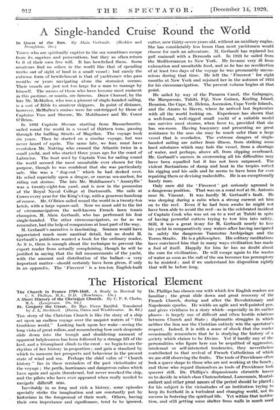A Single-handed Cruise Round the World
Tilosc,who are spiritually captive to the sea sometimes escape from its caprices and persecutions, but they as often return to it of their own free will. It has bewitched them. Some amateurs find no solace in the world like that of spending weeks out of sight of land in a small vessel ; but surely the extreme form of bewitchment is that of yachtsmen who pass months or years navigating alone the stormiest oceans. Their vessels are just not too large for a man to manage by himself. The names of those who have become most eminent in this pastime, or mania, are famous. Down Channel, by the late Mr. McMullen, who was a pioneer of single-handed sailing, is a sort of Bible to amateur skippers. In point of distance, however, McMullen's cruises were far outstripped by those of Captains Voss and Slocum, Mr. Muhlhauser and Mr. Conor O'Brien.
In 1892 Captain Slocum starting from Massachusetts. sailed round the world in a vessel of thirteen tons, passing through the baffling Straits of Magellan. The voyage took six years. Then he started on a similar voyage, but was never heard of again. The same fate, we fear, must have overtaken Mr. Nutting who crossed the Atlantic twice in a small yacht, and who started three years ago for the coast of Labrador. The boat used by Captain Voss for sailing round the world seemed the most unsuitable ever chosen for the purpose, though he was confident that she was particularly safe. She was a " dug-out " which he had decked over. He relied especially upon a drogue, or canvas sea-anchor, for riding out storms. The late Mr. Muhihauser's ' Amaryllis ' was a twenty-eight-ton yawl, and is now in the possession of the Royal Naval College at Dartmouth. She sails at Cowes every year for the King's Cup, with a generous handicap of course. Mr. O'Brien sailed round the world in a twenty-ton ketch, with a large square-sail. Now we must add to the list of circumnavigators the well-known French lawn tennis champion, M. Main Gerbault, who has performed his feat single-handed. The other circumnavigators, so far as we remember, had the help of companions at least part of the way.
M. Gerbault's narrative is fascinating. Seamen would have appreciated much more nautical detail, but no doubt M. Gerbault's publishers wanted a book for the ordinary reader. As it is, there is enough about the technique to prevent the expert reader from actually complaining, though he will be justified in saying that the full measurements of the yacht, with the amount and distribution of the ballast—a very important matter—should certainly have been given, if only in an appendix. The Firecrest ' is a ten-ton English-built cutter, now thirty-seven years old, without an auxiliary engine. She has considerably less beam than most yachtsmen would
choose for such an adventure. M. Gerbault has replaced he gaff mainsail with a Bermuda sail. In 1923 he sailed from the Mediterranean to New York. He became very ill from exhaustion and unsuitable food, and as he has no recollection of at least two days of the voyage he was presumably uncon- scious during that time. He left the Firecrest ' for eight months at New York and rejoined her in the autumn of 1924 for his circumnavigation. The present volume begins at that point.
He sailed by way of the Panama Canal, the Galapagos, the Marquessas, Tahiti, Fiji, New Guinea, Keeling. Island, Reunion, the Cape, St. Helena, Ascension, Cape Verde Islands, and the Azores to Havre, where he arrived last. September with all the world looking on. Experience has shown that a well-found, well-rigged small yacht of a suitable model can survive most storms, when hove to, provided that she has sea-room. Having buoyancy and presenting no great resistance to the seas she may be much safer than a large vessel that is overladen. The extreme dangers of single- handed sailing are rather from illness, from striking some hard substance which may hole the vessel, from a shortage of water, and perhaps, above all, from slipping overboard. Mr. Gerbault's success in overcoming all his difficulties may have been equalled but it has not been surpassed. The violent fluctuations of damp and heat in the tropics rotted his rigging and his sails and he seems to have been for ever repairing them or devising makeshifts. He is an exceptionally handy man.
Only once did the Firecrest ' get seriously aground in a dangerous position. That was on a coral reef at St. Antonio near St. Vincent. It was hardly M. Gerbault's fault. He was sleeping during a calm when a strong current set him on to the reef. Even if he had been awake he might not have been able to avoid the reef—as in the celebrated incident of Captain Cook who was set on to a reef at Tahiti in spite of having powerful cutters trying to tow him into safety. Still, it was a great irony for M. Gerbault nearly to lose his yacht in comparatively easy waters after having navigated in safety the dangerous Tuamotus Archipelago and the Torres Straits. He is a philosopher. His solitary meditations have convinced him that in many ways civilization has made a fool of itself. Happily for him he has no doubt about the cure for civilization. He will escape again to the wastes of water as soon as the call of the sea becomes too peremptory to be resisted ; and if we understand his disposition rightly that will be before long.












































 Previous page
Previous page